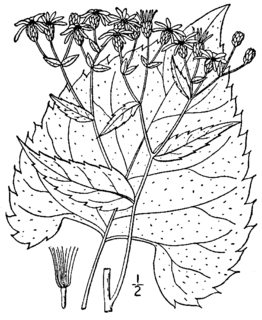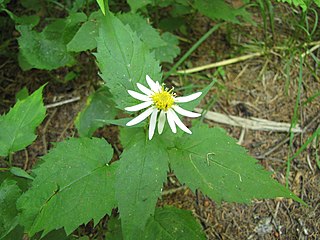
Oclemena is a small genus of North American flowering plants in the tribe Astereae within the family Asteraceae.

Eurybia macrophylla, commonly known as the bigleaf aster, large-leaved aster, largeleaf aster or bigleaf wood aster, is an herbaceous perennial in the family Asteraceae that was formerly treated in the genus Aster. It is native to eastern North America, with a range extending from eastern and central Canada through the northeastern deciduous and mixed forests of New England and the Great Lakes region and south along the Appalachians as far as the northeastern corner of Georgia, and west as far as Minnesota, Missouri and Arkansas. The flowers appear in the late summer to early fall and show ray florets that are usually either a deep lavender or violet, but sometimes white, and disc florets that are cream-coloured or light yellow, becoming purple as they mature. It is one of the parent species of the hybrid Eurybia × herveyi.

Eurybia divaricata, commonly known as the white wood aster, is an herbaceous plant native to eastern North America. It occurs in the eastern United States, primarily in the Appalachian Mountains, though it is also present in southeastern Canada, but only in about 25 populations in the provinces of Ontario and Quebec. In the U.S. it is abundant and common, but in Canada it is considered threatened due to its restricted distribution. It can be found in dry open woods as well as along wood-edges and clearings. The species is distinguished by its flower heads that have yellow centers and white rays that are arranged in flat-topped corymbiform arrays, emerging in the late summer through fall. Other distinguishing characteristics include its serpentine stems and sharply serrated narrow heart-shaped leaves. The white wood aster is sometimes used in cultivation in both North America and Europe due to it being quite tough and for its showy flowers.

Eurybia schreberi, commonly called Schreber's aster or nettle-leaved Michaelmas-daisy, is a perennial herb in the family Asteraceae. It is native to eastern North America, where it is present in Canada and the United States. The flower heads emerge in the late summer or early fall to show white ray florets and yellow disc florets. It is listed as endangered in Indiana and Iowa, of special concern in Tennessee and possibly extirpated in Maine.
Eurybia avita, commonly called Alexander's rock aster, is a rare North American plant species, a herbaceous perennial in the family Asteraceae that was formerly considered part of the genus Aster. It is native to the southeastern United States. It is of conservation concern as it is found in less than 50 sites, typically only in sandy soils near granite flatrocks, and it is most likely already extirpated in North Carolina. Its habitat is threatened by development and the recreational use of the area where it grows. It is very similar to both E. surculosa and E. paludosa and more research needs to be done to determine the exact relationship between the three species.
Eurybia spinulosa, commonly called the Apalachicola aster or pinewoods aster, is a perennial herb in the family Asteraceae. It is native to the south eastern United States, where it is present only in the Florida panhandle. Due to its restricted habitat, which is confined to the Apalachicola river drainage, as well as to ongoing development in these areas, the species is of serious conservation concern. It has been listed as critically imperiled by the Nature Conservancy and endangered by the state of Florida.

Eurybia spectabilis, commonly known as the eastern showy aster, simply showy aster or purple wood aster, is an herbaceous perennial native to the eastern United States. It is present along the coastal plain of the U.S. where it is most often found growing in dry, sandy soils. Although it is not considered threatened due to its extensive range, it is locally endangered in many states. The flowers appear in the fall and show ray florets that are a violet-purple and yellow disc florets. It is one of the parent species of the hybrid Eurybia × herveyi.

Eurybia chlorolepis, commonly known as the mountain wood aster, mountain aster, or Appalachian heartleaf aster, is a perennial, herbaceous plant native to the southeastern United States. It is present only at relatively high elevations in the Appalachian mountains. Although it is not considered seriously threatened due to a large number of sites in some of its range, it is often locally endangered and possibly extirpated in the south of its range.

Eurybia compacta, commonly known as the slender aster, is an herbaceous perennial native to the eastern United States from New Jersey to Georgia. It is commonly found along the coastal plain in dry sandy soils, especially in pinelands. While it is not considered to be in high danger of extinction, it is of conservation concern and has most likely been extirpated from much of its original range. The slender aster was for a long time considered to be a variety of E. surculosa, but Guy Nesom's recent research within the genus has shown that it is distinct enough to be treated as a species. It has also been shown to be related to E. avita and E. paludosa.

Eurybia conspicua, commonly known as the western showy aster, is a North American species of plants in the family Asteraceae. It is native to western Canada and the western United States.

Eurybia eryngiifolia, commonly known as the thistleleaf aster or coyote-thistle aster, is an herbaceous perennial in the family Asteraceae. It is native to the eastern United States where it is only present along the Florida panhandle and the nearby areas of southern Alabama and southwestern Georgia.
Eurybia radulina, commonly known as the roughleaf aster, is an herbaceous perennial in the family Asteraceae. It is native to western North America, where it is present primarily west of the Cascade Range in both Canada and the United States. Its habitats include dry rock outcrops, slopes, edges of forests, and oak woodlands.
Eurybia paludosa, commonly known as the southern swamp aster, is an herbaceous perennial in the family Asteraceae. It is native to the southeastern United States where it is confined to the Carolinas and the states of Georgia and Florida. It is generally confined to moist soils, though it can occasionally be found on sand hills along the coastal plain. The southern swamp aster is often confused with the closely related southern prairie aster, though they do not occur in the same habitats or geographical areas. Its flower heads emerge in the late summer through fall and show deep lavender to purple rays with yellow centres.
Eurybia mirabilis, commonly known as the bouquet aster or dwarf aster, is an herbaceous perennial in the family Asteraceae. It is endemic to the lower Piedmont of North Carolina and South Carolina in the southeastern United States. Within this small range it is found only infrequently, making it of conservation concern. The species is now largely confined to inaccessible bluffs due to the conversion of other habitats to farmland. It typically grows in deciduous or mixed deciduous woods, as well as on slopes or alluvial plains. Basic to neutral soils are usually preferred. Its flower heads emerge in the late summer to early fall and show white to lavender rays with pale yellow centres sometimes tinged with purple.
Herrickia is a North American genus of flowering plants in the family Asteraceae, native to the western United States. All the species were included in Aster before molecular studies triggered the splitting of that genus into several distinct genera.
Herrickia horrida is a species of flowering plant in the family Asteraceae known by the common name horrid herrickia. It is native to Colorado and New Mexico in the United States, where it occurs only in the Animas River basin. It is often included in genus Eurybia.

Herrickia glauca is a North American species of flowering plants in the family Asteraceae, called the gray aster. It is native to the western United States, primarily in Arizona, New Mexico, Utah, Colorado, and Wyoming, with a few populations in Idaho and Montana.

Herrickia kingii is a North American species of flowering plants in the family Asteraceae, called the King's serpentweed or King's aster. It has been found only in the State of Utah in the western United States.

Symphyotrichum pygmaeum is a species of flowering plant in the family Asteraceae native to north Alaska, the Yukon, and Northwest Territories. Commonly known as pygmy aster, it is a perennial, herbaceous plant that may reach 1.5 to 15 centimetres tall. Its flowers have purple to violet ray florets and yellow disk florets.

Symphyotrichum chapmanii is a species of flowering plant in the family Asteraceae native to the Apalachicola River drainage basin of Alabama and Florida. Commonly known as savanna aster, it is a perennial, herbaceous plant that may reach 30 to 80 centimeters tall. Its flowers have purple to blue-lavender ray florets and pale yellow disk florets. It is a wetland species and is of conservation concern. It may be extirpated in Alabama.












